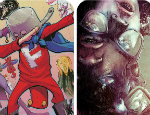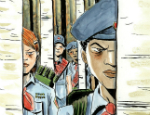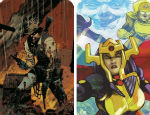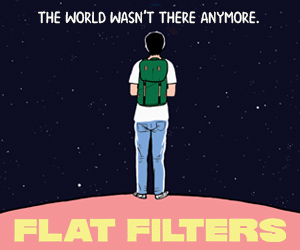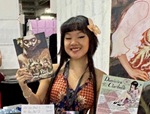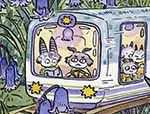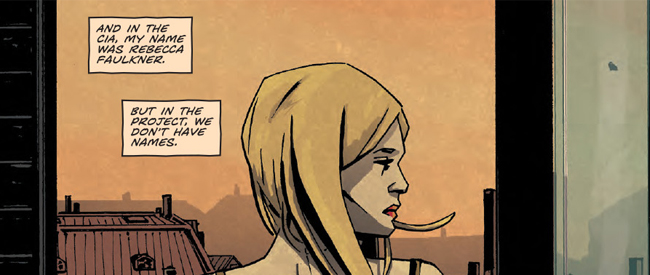
In the real world of international espionage, there’s no such thing as a Widow’s Sting or a one-eyed, cigar-chomping “man on the wall” looking out for the rest of us. Martinis – whether shaken or stirred – aren’t a normal part of top secret tradecraft. And despite what Hollywood would have us believe, there’s not much in the way of parkour, pyrotechnics, or impossibly pretty ladies waiting to jump your bones in the spy game.
Comic books, like the film industry, tend to idealize and sexualize their heroic female archetypes. This is what we call an indisputable fact. Despite their popularity with the majority of 18-45 year old men, characters like Black Widow, Sharon Carter, and Mockingbird are nothing more than male-driven power fantasies that have nothing to do with real-life spying.
In Butterfly, their new four-issue limited series from BOOM! Studios, screenwriter Arash Amel (Grace of Monaco, Erased) and popular comics scribe Marguerite Bennett (Batgirl) team up with artist Antonio Fuso (The Girl Who Played with Fire) to present a much more realistic and relevant depiction of the female spy.
Exploring themes such as family, identity, and the psychology of deep cover, Butterfly chronicles the labyrinthine web of lies, betrayals, and family ties that threaten one Rebecca Faulkner, perhaps the most realistic female spy to hit comics since Queen and Country’s Tara Chace.
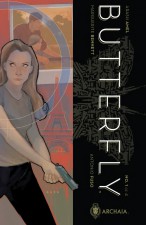 Arash, can you give us a bit of history behind the development of Butterfly? What makes comics a perfect vehicle for this spy story?
Arash, can you give us a bit of history behind the development of Butterfly? What makes comics a perfect vehicle for this spy story?
Arash Amel: Comics is a visual medium where you can keep a story playing on multiple levels and be free to push it in any particular direction – more so than film and I’d argue even more than a TV show.
My approach to writing is that any story is ultimately only ever about characters and worlds – story flows from that, and the place you can do that with the most freedom is comics.
I had a very large and expansive universe in mind for the world our spies to occupy, which I wanted to see come alive, and that couldn’t have happened anywhere else but comics.
How did the writing process work for the two of you on such a tightly plotted book?
Arash: I had an initial story arc in mind, which forms the basis of the first four issues, which is very much an origin story for what will come in future installments.
Marguerite then showed up with a spectacular take on the material in terms of the humanity and the relationship between father and daughter, which is all that I wanted us to focus on, and a very unique ‘reverse-history’ writing technique which you’ll see in the part of the book dealing with Nightingale (the heroine’s late father).
We worked closely together on a detailed story outline, and then Marguerite just went away and wrote this amazing script, which we then tweaked together. My key guidance was to let the plot happen in the background, and let the silences speak for themselves – less is more here, using cinematic storytelling techniques in a comic form, so while it’s tightly plotted, it’s all subtext and you’re riding the emotion rather than the plot. I think Marguerite did a beautiful job.
Marguerite Bennett: This project is Arash’s baby; I’m just the schoolteacher. It is entirely the child of his mind, interests, and aesthetic; I’m the one teaching it to be a comic, to exist and then to excel within the medium, to make the most of its strengths.
We would have calls that lasted for hours, fine tuning, trading ideas, cracking jokes, ramping up tension and action and mystery. Even beyond the necessary continuity to write superhero comics, this was by far the most demanding project I worked on, but its deep roots in our culture and history made it one of the most rewarding.
Rebecca Faulkner isn’t your typical comic book female spy, in the vein of, say, Black Widow. But that isn’t to say she isn’t formidable. What do you think are some of the major misconceptions about modern espionage, especially with regards to women?
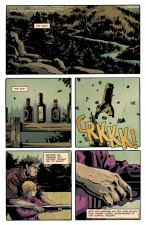 Arash: The key to Butterfly was not to sexualize her. That’s a big point of contention for me with female espionage concepts. Whether it’s Black Widow or Nikita and so on, there’s a strong urge to trade off the femininity to define who these characters are. I wanted to go against all of that and totally against the Bond archetype.
Arash: The key to Butterfly was not to sexualize her. That’s a big point of contention for me with female espionage concepts. Whether it’s Black Widow or Nikita and so on, there’s a strong urge to trade off the femininity to define who these characters are. I wanted to go against all of that and totally against the Bond archetype.
She’s a very tough and dangerously elusive black ops agent, and the fact she happens to be a woman is a coincidence. She’s just an ordinary young woman from Virginia called Becky who you could go for a beer with, or hang out with.
She’s not unreachable, and frankly you could be sitting next to her on the subway or bump into her in the street. It just happens she’s an elite-trained soldier and her job is totally compartmentalized murder and deceit – a monster in her own way.
That’s not to say she won’t use the whole range of skills her sex allows her; it’s just that it’s an aside, and I don’t ever want us to trade on that – which again is why it was so important for me to have Marguerite write this, because I knew the humanity she’d bring to Rebecca.
In a weird way, I wanted to create a spy character girls could look at and say, ‘if I was a spy, that’s the spy I’d be’ – similar to boys with Bourne and Bond.
Marguerite: Very good question with lots of working parts! Let me tackle these one at a time.
No, Butterfly is decidedly not a traditional spy. Our image of a comic book spy – or at least a female comic book spy – is a femme fatale and secret agent. Butterfly is an actress. She is designed to vanish within a role, to go entirely off the radar, even to her own masters, losing herself in the parts she plays. She is not a soldier, not a fighter – though she is utterly vicious when cornered. Her skill set is singular and subtle – the enemy you never suspect.
Major misconceptions about modern espionage is a trickier question. I would say the largest misconception is where or how it isn’t happening. Everything we do digitally is recorded. Every piece of sensitive data, from our phones to our bank servers, is insecure. Corporations that specialize in the sale of security – providing a sense of comfort to the buyer, in addition to the promise of safety of sensitive data – would prefer to downplay this. Every system – human, mechanical, digital, national – has vulnerabilities, and Butterfly is there to seek them out and exploit them.
Major misconceptions about the role of women in modern espionage is trickier. We envision the vixen, the femme fatale – Elsa at the end of Indiana Jones, the harem of Bond girls. Many of the images are those popularized by the media of the Cold War; while honeypots captured a large number of “enemies of the state” in decades gone by, our media has drowned us in dangerous female sexuality while neglecting dangerous female intellect. Butterfly represents not iconic sensuality, but shifting, faceless, subtle cunning – as persistent and mutating as a digital virus.
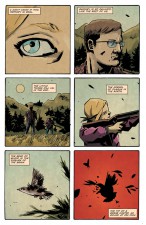 How has Rebecca’s relationship with her father shaped her espionage career? Did she ever have a chance for a normal life with a father like hers?
How has Rebecca’s relationship with her father shaped her espionage career? Did she ever have a chance for a normal life with a father like hers?
Arash: Without giving too much away, her life was defined by her father’s actions both before and after his disappearance. Her chance at a normal life was very brief, though it was there for a while.
Marguerite: Butterfly idolized her father. She was told he died a hero – a messy death in sun and sand, but a heroic one regardless. She desired to follow in his footsteps, carried him as this infallible figure in her heart. He could never disappoint her, never fail her, but his legend poisoned her just the same. Her desire to be like him was the final push that sent her to the Department of Defense and led her down this violent, sinister path.
What were some of the more interesting lines of research you embarked upon while developing Butterfly?
Arash: I spoke to a number of operatives in Special Forces and also the CIA; it was pretty eye-opening to see how much of the bureaucracy and processes we were thinking about depicting are actually very real. We wanted to be as real as possible here – this is a boots-on-the-ground real-world spy game, with the consequences of sacrificing family for country.
Marguerite: The history of the United States’ intervention in democratically elected nations was deeply disheartening. Even though one grows up through the school system and learns snippets and whispers around the truth, reading primary accounts and taking it upon yourself to further your own education was as hurtful as it was necessary.
I’m also bizarrely well-versed in Soviet rifles now, down to which factories produced them and where they were located. When I am inevitably questioned by the authorities, I will only be able to say, “I did it for comics.”
Timing is everything in comics, and you choose your moments remarkably well in Butterfly. In a comic where creating tension and suspense is of such paramount concern, what constitutes the perfect moment for you?
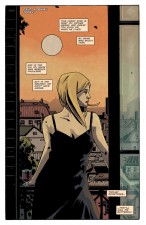 Marguerite: That’s a very kind thing to say! If I were to choose a type of moment – one I love, which cannot be translated into film or prose – it would be an introduction that is also a revelation.
Marguerite: That’s a very kind thing to say! If I were to choose a type of moment – one I love, which cannot be translated into film or prose – it would be an introduction that is also a revelation.
I admit this is my favorite style of opening: a first page dense with panels, sometimes growing ever smaller, bringing a sense of claustrophobia, winding tighter and tighter in a sense of dread, paranoia, tension – and then the explosion of a splash or double-page splash as the situation is either made plain or the tension released, often to violent ends.
Arash: The silences! It allows Antonio Fuso’s beautiful artwork to do the work, and the storytelling becomes as visual as possible. This is where a lot of the tension is generated from.
Bridgewell seems like a particularly shady company. What can you tell us about this organization and the role they play in Butterfly?
Arash: Very little, I don’t want to spoil the surprise [smiling].
Marguerite: Next to nothing, other than that Butterfly must be very, very careful.
Although only solicited as a four-issue limited series, it’s easy to envision Butterfly as a creative property that could cross over into different media. Are there any plans at this time to explore sequels or adaptations in other media?
Marguerite: Arash has big, wonderful plans for Butterfly, and I am dying for her story to reach an audience as vast as it deserves.
Arash: Yes, there are. These four issues are just the beginning…
Butterfly #1 will be published by BOOM! Studios later in September.





